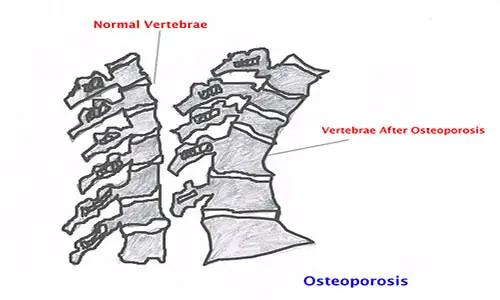1.Osteoporosis is a disease of the bones.
- It came from the Greek word ‘osteo’ means bone and ‘porosis’ means porous.
- It is a condition where tissue structures become abnormal due to loss of bone density and mass.
- Bones may become brittle and increases its fragility.
2.Osteoporosis is a silent disease.
- Osteoporosis is not literally losing a bone.
- It is actually an alteration of bone quality and deterioration of bone tissue.
- It is a progressive bone disease.
- The onset is gradual and painless.
- Symptoms may only appear on the advanced stage of the disease.
3.Osteoporosis is common among Female.
- It is seen on women of increasing age usually older than 50.
- Besides slow postural reflex that makes elderly more at risk for fall, osteoporosis is also associated with hormonal changes after menopause.
- This is termed as primary osteoporosis.
- Hormones are modulators of bone formation for optimal bone maintenance.
- They play an auxiliary and supportive role in regulating bone cells.
4. Osteoporosis is diagnosed by bone mineral density measurement.
- This is a diagnostic procedure as well as preventive measure against osteoporosis.
- Dual energy X-ray absorptiometry is used to measure bone density at the spine which is FDA approved.
- Laboratory testing of blood serum calcium level is also helpful to check for calcium deficiency.
5. Osteoporosis is risk factor for fractures.
- Bone fracture is one of the major complications of a porous bone.
- Even on minor fall or a bump into something hard where the vulnerable bony parts received the impact, you can break your bone so easily.
- Mortality of osteoporosis is due to complications of fracture such as deep venous thrombosis or pulmonary embolism.
6. Osteoporotic fracture site is common at the spine or hip.
- Spinal fracture secondary to osteoporosis may lead to occurrence of chronic pain neurologic in origin brought about by nerve involvement.
- This is due to compression because of pressure placed on the weakened vertebrae (small bones of the spine).
7. Osteoporosis has a possible strong genetic component.
- Genetic factors are determinants of osteoporotic fracture risk.
- In rare instances, mutation of a single gene contributes to development of osteoporosis.
8. Osteoporosis can be drug induced.
- This is termed as secondary osteoporosis.
- Glucocorticoid medicines tend to reduce the rate of new bone formation.
- Synthetic steroids also interfere with the metabolism and absorption of essential calcium in the body.
- Other drugs that may cause the bone to weaken are non-steroidal anti-inflammatory drugs (NSAID) which inhibits certain kind of molecular activity in bone remodeling
9. Osteoporosis may cause disconcerting physical deformities.
- Most common physical skeletal distortions are kyphosis and scoliosis secondary to osteoporosis.
- Osteoporosis can be managed non-surgically but the deformity is another story.
- But with advancement in technology surgical manipulation to correct deformity is now available.
- Vertebroplasty and kyphoplasty are among those innovative techniques.
10. Osteoporosis can be prevented.
- A sedentary lifestyle may cause a lot of health related illnesses.
- Exercise is the best way to keep your bones strong especially those activities that makes you work against gravity.
- This types of exercises help improve balance and posture
- Examples are weight bearing exercises such as walking, jogging or climbing stairs and strengthening exercises such as free light weight lifting (use of small dumbbells) or use of resistance band.
- Foods or supplements high in calcium and vitamin D can help to build strong bones.
- Calcium helps build strong bones but it should be taken along with vitamin D for absorption.











Leave a Reply